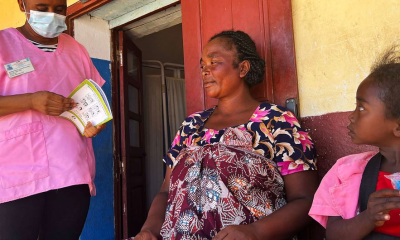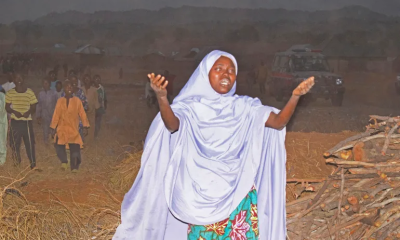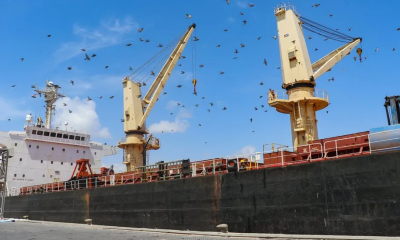Foreign News
Sudan catastrophe must not be allowed to continue- UN rights chief Türk

A full year of conflict in Sudan has already caused immense suffering and death but the situation could easily worsen with the news that the warring parties are arming civilians, UN rights chief Volker Türk said on Monday.
A year to the day since heavy fighting erupted between Sudan’s rival militaries, the UN High Commissioner for Human Rights warned of a further escalation, including an imminent attack on El-Fasher in North Darfur.
“The Sudanese people have been subjected to untold suffering during the conflict which has been marked by indiscriminate attacks in densely populated areas, ethnically-motivated attacks, and a high incidence of conflict-related sexual violence. The recruitment and use of children by parties to the conflict are also deeply concerning,” said Mr. Türk.
And as an international donor conference for the Sudan emergency began in Paris on Monday, the UN rights chief underscored the potential for further bloodshed, as three armed groups announced that they were joining the Sudanese Armed Forces in their fight against the Rapid Support Forces and “arming civilians”.
Since fighting erupted on 15 April 2023, more than eight million people have been displaced, including at least two million to neighbouring countries.
“Nearly 18 million people face acute food insecurity, 14 million of them children, and over 70 per cent of hospitals are no longer functional amid a rise in infectious diseases – this catastrophic situation must not be allowed to continue,” said High Commissioner Türk.
Acute hunger danger
Echoing those concerns, the UN Children’s Fund (UNICEF) said that some 8.9 million children are suffering from acute food insecurity; this includes 4.9 million at emergency levels.
“Almost four million children under five are projected to suffer from acute malnutrition this year”, including 730,000 from life-threatening severe acute malnutrition, UNICEF said in a statement on Sunday. “Almost half of the children suffering from severe acute malnutrition are in areas that are hard to access” and where there is ongoing fighting, noted UNICEF Deputy Executive Director, Ted Chaiban. “This is all avoidable, and we can save lives if all parties to the conflict allow us to access communities in need and to fulfil our humanitarian mandate – without politicizing aid.”
Civilian rule targeted
Top UN rights official Türk also expressed deep concern that arrest warrants had been issued against former Prime Minister Abdallah Hamdok and others on apparently unsubstantiated charges.
“The Sudanese authorities must immediately revoke the arrest warrant and prioritize confidence-building measures towards a ceasefire as a first step, followed by a comprehensive resolution of the conflict and the restoration of a civilian government,” Mr. Türk insisted.
UN humanitarians meanwhile have reiterated that chronic hunger and malnutrition continue to make children “much more vulnerable to disease and death”.
Conflict has also disrupted vaccination coverage in Sudan and safe access to drinking water, UNICEF explained, meaning that ongoing disease outbreaks such as cholera, measles, malaria and dengue now threaten the lives of hundreds of thousands of children.
“Spikes in mortality, especially among internally displaced children, are a forewarning of a possible huge loss of life, as the country enters the annual lean season,” the UN agency said, as it underlined the need for predictable and sustained international aid access.
“Basic systems and social services in Sudan are on the brink of collapse, with frontline workers not being paid for a year, vital supplies depleted, and infrastructure, including hospitals and schools, still under attack.”
Schools shuttered
And in a warning that the whole country could be engulfed in fighting that has left half of Sudan’s population in need of humanitarian relief, the global fund for education in emergencies, Education Cannot Wait, underscored that four of the eight million people uprooted by the violence are children.
The conflict “continues to take innocent lives, with over 14,000 children, women and men reportedly killed already,” said Yasmine Sherif, Executive Director of Education Cannot Wait.
Ms. Sherif echoed deep concerns that Sudan now has one of the worst education crises in the world, with more than 90 per cent of the country’s 19 million school-age children unable to access formal education.
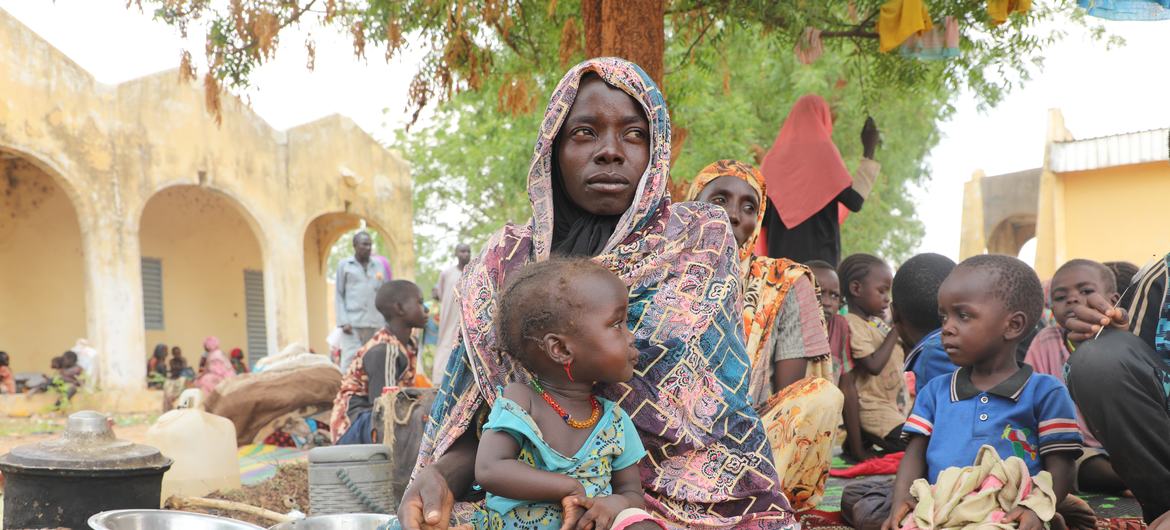
Mariam Djimé Adam, 33, is sitting in the yard of Adre’s secondary school in Chad. She arrived from Sudan with her 8 children. (UNICEF)
“Most schools are shuttered or are struggling to re-open across the country, leaving nearly 19 million school-aged children at risk of losing out on their education,” she said.
To date, the global fund has provided nearly $40 million to support education for victims of the crisis in Sudan and beyond, in the Central African Republic, Chad, Egypt, Ethiopia and South Sudan.
“Without urgent international action, this catastrophe could engulf the entire country and have even more devastating impacts on neighbouring countries, as refugees flee across borders into neighbouring States,” Ms. Sherif said.
(UN News)
Foreign News
Nasa ‘Earthrise’ astronaut dies at 90 in plane crash

Apollo 8 astronaut Bill Anders, who snapped one of the most famous photographs taken in outer space, has died at the age of 90.
Officials say a small plane he was flying crashed into the water north of Seattle, Washington.
Anders’ son Greg confirmed that his father was flying the small plane, and that his body was recovered on Friday afternoon. “The family is devastated. He was a great pilot. He will be missed,” a statement from the family reads.
Anders – who was a lunar module pilot on the Apollo 8 mission – took the iconic Earthrise photograph, one of the most memorable and inspirational images of Earth from space.
Taken on Christmas Eve during the 1968 mission, the first crewed space flight to leave Earth and reach the Moon, the picture shows the planet rising above the horizon from the barren lunar surface.
Anders later described it as his most significant contribution to the space programme.
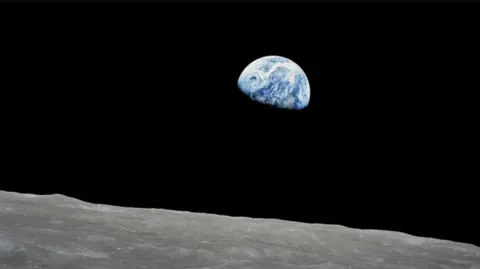
The image is widely credited with motivating the global environmental movement and leading to the creation of Earth Day, an annual event to promote activism and awareness of caring for the planet.
Speaking of the moment, Anders said: “We came all this way to explore the Moon, and the most important thing that we discovered was the Earth.”
Officials said on Friday that Anders crashed his plane around 11:40PDT (1940BST).
The US National Transportation Safety Board (NTSB) said the 90-year-old was flying a Beechcraft A A 45 – also known as a T-34. The agency said that the plane crashed about 80ft (25m) from the coast of Jones Island.
Anders also served as the backup pilot to the Apollo 11 mission, the name of the effort that led to the first Moon landing on July 24, 1969.
Following Anders’ retirement from the space programme in 1969, the former astronaut largely worked in the aerospace industry for several decades. He also served as US Ambassador to Norway for a year in the 1970s.
But he is best remembered for the Apollo 8 mission and the iconic photograph he took from space.
“In 1968, during Apollo 8, Bill Anders offered to humanity among the deepest of gifts an astronaut can give. He traveled to the threshold of the Moon and helped all of us see something else: ourselves,” Nasa Administrator Bill Nelson said in a statement.
Mark Kelly, a former astronaut who now serves as a US Senator for the state of Arizona, said in a post on X, formerly Twitter, that Anders “inspired me and generations of astronauts and explorers. My thoughts are with his family and friends”.
[BBC]
Foreign News
China’s Chang’e-6 lifts off from far side of Moon with rock samples

A Chinese spacecraft carrying rock and soil samples from the far side of the Moon has lifted off from the lunar surface to start its journey back to Earth, according to state media.
The achievement on Tuesday is a world first and the latest leap for Beijing’s decades-old space programme, which aims to send a crewed mission to the Moon by 2030.
The Xinhua News Agency, citing the China National Space Administration (CNSA), said that the ascender of the Chang’e-6 probe took off at 7:38am local time on Tuesday (23:38 GMT) and entered a preset orbit around the moon.
It described the move as “an unprecedented feat in human lunar exploration history”.
The Chang’e-6 probe was launched last month and its lander touched down on the far side of the Moon on Sunday. It used a drill and robotic arm to dig up soil on and below the Moon’s surface, according to Xinhua.
After successfully gathering its samples, the Chang’e-6 unfurled China’s national flag for the first time on the far side of the Moon, it said.
The agency cited the CNSA as saying that the spacecraft stowed the samples it had gathered in a container inside the ascender of the probe as planned.
[Aljazeera]
Foreign News
China says its spacecraft lands on Moon’s far side

China says its uncrewed craft has successfully landed on the far side of the Moon – an unexplored place almost no-one tries to go.
The Chang’e 6 touched down in the South Pole-Aitken Basin at 06:23 Beijing time on Sunday morning (22:23 GMT Saturday), the China National Space Administration (CNSA) said.
Launched on 3 May, the mission aims to collect precious rock and soil from this region for the first time in history. The probe could extract some of the Moon’s oldest rocks from a huge crater on its South Pole.
The landing was fraught with risks, because it is very difficult to communicate with spacecraft once they reach the far side of the Moon. China is the only country to have achieved the feat before, landing its Chang’e-4 in 2019.
After launching from Wenchang Space Launch Center, the Chang’e 6 spacecraft had been orbiting the Moon waiting to land. The lander component of the mission then separated from the orbiter to touch down on the side of the Moon that faces permanently away from Earth.
During the descent, an autonomous visual obstacle avoidance system was used to automatically detect obstacles, with a visible light camera selecting a comparatively safe landing area based on the brightness and darkness of the lunar surface, the CNSA was quoted as saying by state-run Xinhua news agency.
The lander hovered about 100m (328ft) above the safe landing area, and used a laser 3D scanner before a slow vertical descent. The operation was supported by the Queqiao-2 relay satellite, the CNSA said.
Chinese state media described the successful landing as an “historic moment”. The state broadcaster said “applause erupted at the Beijing Aerospace Flight Control Center” when the Chang’e landing craft touched down on the Moon early on Sunday morning.
The lander should spend up to three days gathering materials from the surface in an operation the CNSA said would involve “many engineering innovations, high risks and great difficulty”. “Everyone is very excited that we might get a look at these rocks no-one has ever seen before,” explains Professor John Pernet-Fisher, who specialises in lunar geology at the University of Manchester.
He has analysed other lunar rock brought back on the American Apollo mission and previous Chinese missions. But he says the chance to analyse rock from a completely different area of the Moon could answer fundamental questions about how planets form.
Most of the rocks collected so far are volcanic, similar to what we might find in Iceland or Hawaii. But the material on the far side would have a different chemistry . “It would help us answer those really big questions, like how are planets formed, why do crusts form, what is the origin of water in the solar system?” the professor says.
The mission aims to collect about 2kg (4.4lb) of material using a drill and mechanical arm, according to the CNSA.
The South Pole–Aitken basin, an impact crater, is one of the largest known in the solar system.
From there, the probe could gather material that came from deep inside the lunar mantle – the inner core of the Moon – Prof Pernet-Fisher says.
The Moon’s South Pole is the next frontier in lunar missions – countries are keen to understand the region because there is a good chance it has ice.
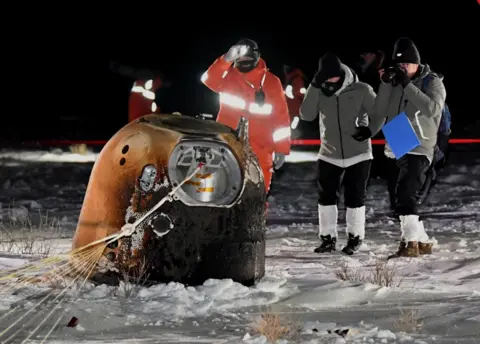
The capsule in the last Chinese moon mission, Chang’e 5, brought back soil and rocks in 2020 (BBC)
Access to water would significantly boost the chances of successfully establishing a human base on the Moon for scientific research.
If the mission succeeds, the craft will return to Earth with the precious samples on board a special return capsule.
The material will be kept in special conditions to try to keep it as pristine as possible.
Scientists in China will be given the first chance to analyse the rocks, and later researchers around the world will be able to apply for the opportunity too.
This is the second time China has launched a mission to collect samples from the Moon.
In 2020 Chang’e 5 brought back 1.7kg of material from an area called Oceanus Procellarum on the Moon’s near side.
China is planning three more uncrewed missions this decade as it looks for water on the Moon and investigates setting up a permanent base there.
Beijing’s broader strategy aims to see a Chinese astronaut walk on the moon by around 2030.
The US also aims to put astronauts back on the moon, with Nasa aiming to launch its Artemis 3 mission in 2026.
(BBC)






